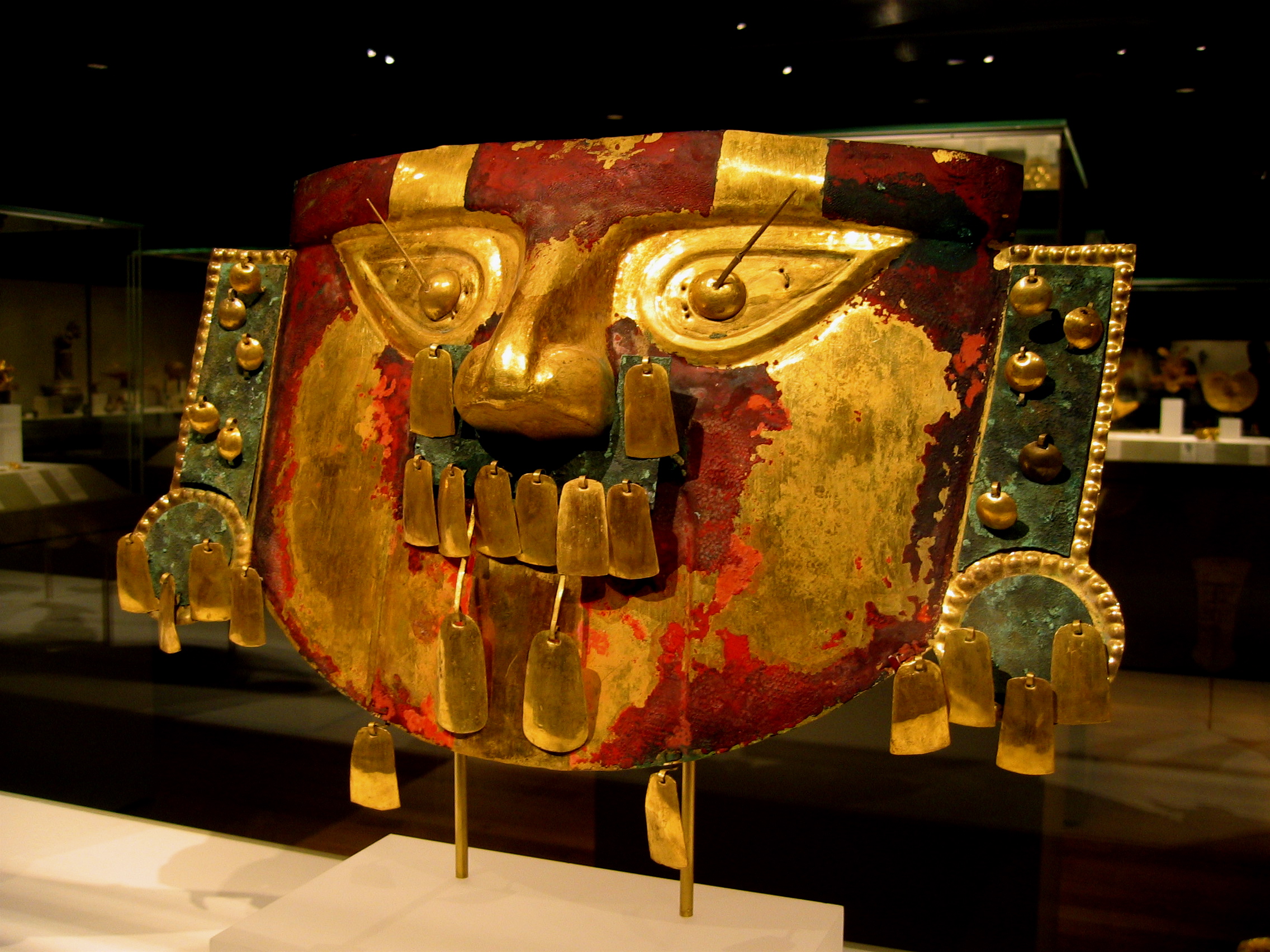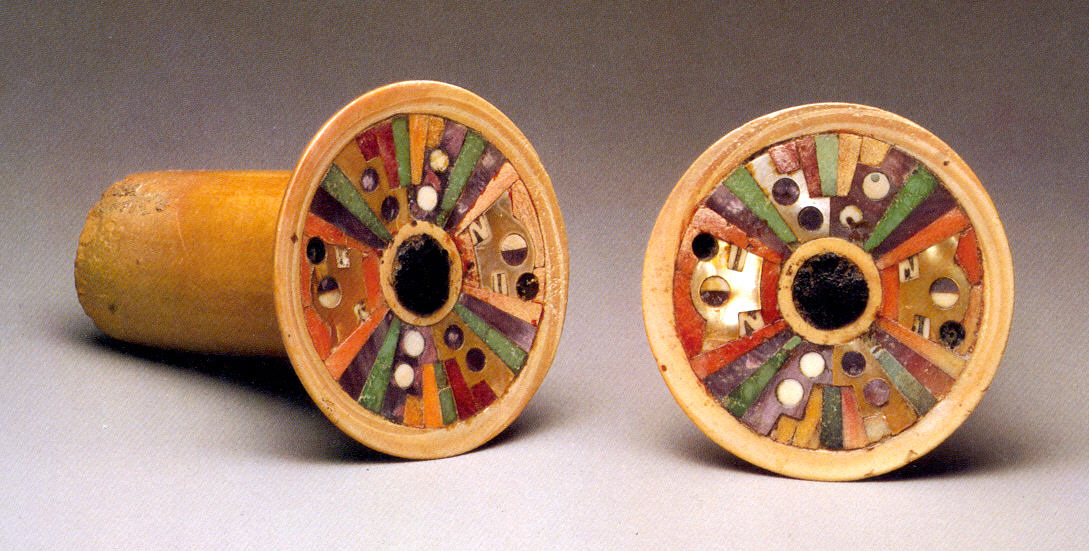|
Chimor
Chimor (also Kingdom of Chimor or Chimú Empire) was the political grouping of the Chimú culture. The culture arose about 900 AD, succeeding the Moche culture, and was later conquered by the Inca emperor Topa Inca Yupanqui around 1470, fifty years before the arrival of the Spanish in the region. Chimor () was the largest kingdom in the Late Intermediate Period, encompassing 1,000 kilometres (620 mi) of coastline. The Chimor dynasty begins with two origin myths about the Naymlap dynasty that were orally passed down and conserved. The first legend begins with the arrival of Taycanamo in the Moche Valley after he crossed an unknown sea on a balsa raft. From there his descendants would conquer surrounding areas starting with his son Guacricaur. Guacricaur integrated Chimú reign over the lower valley and Ñançenpinco, Taycanamo's grandson would expand the kingdom by conquering the upper valley. Ñançenpinco began to further expansion both north and south of the Moche Va ... [...More Info...] [...Related Items...] OR: [Wikipedia] [Google] [Baidu] |
Chimor–Inca War
The Chimor-Inca War was a conflict fought in the late 15th century between the Inca Empire and the Chimor Empire of coastal Peru. At the time of the conflict, the Chimor Empire was in a process of territorial expansion, but as the Inca Empire appeared in the picture, it became impossible for the Chimor to consolidate its conquests. Early skirmishes occurred when the Inca Empire conquered the non-Chimor inland city of Cajamarca. The Incas led by Topa Inca Yupanqui responded to hostilities by advancing first north to Quito in modern Ecuador and then turning their attention to the Chimor Empire. The Chimor Empire was likely conquered from the north. Once conquered, the Incas established an indirect rule over the Chimor. To consolidate victory the Incas pressured the Chimor to hand over the unruly Chimor cacique A ''cacique'' (Latin American ; ; feminine form: ''cacica'') was a tribal chieftain of the Taíno people, the indigenous inhabitants at European contact of the Bahamas, t ... [...More Info...] [...Related Items...] OR: [Wikipedia] [Google] [Baidu] |
Chan Chan
Chan Chan was the largest city of the pre-Columbian era in South America. It is now an archaeological site in La Libertad Region west of Trujillo, Peru. Chan Chan is located in the mouth of the Moche Valley and was the capital of the historical empire of the Chimor from 900 to 1470, when they were defeated and incorporated into the Inca Empire. Chimor, a conquest state, developed from the Chimú culture which established itself along the Peruvian coast around 900 AD. Chan Chan is in a particularly arid section of the coastal desert of northern Peru. Due to the lack of rain in this area, the major source of nonsalted water for Chan Chan is in the form of rivers carrying surface runoff from the Andes. This runoff allows for control of land and water through irrigation systems. The city of Chan Chan spanned 20 km² and had a dense urban center of 6 km² which contained extravagant ''ciudadelas''. ''Ciudadelas'' were large architectural masterpieces which housed plazas, ... [...More Info...] [...Related Items...] OR: [Wikipedia] [Google] [Baidu] |
Inca Empire
The Inca Empire (also known as the Incan Empire and the Inka Empire), called ''Tawantinsuyu'' by its subjects, ( Quechua for the "Realm of the Four Parts", "four parts together" ) was the largest empire in pre-Columbian America. The administrative, political and military center of the empire was in the city of Cusco. The Inca civilization arose from the Peruvian highlands sometime in the early 13th century. The Spanish began the conquest of the Inca Empire in 1532 and by 1572, the last Inca state was fully conquered. From 1438 to 1533, the Incas incorporated a large portion of western South America, centered on the Andean Mountains, using conquest and peaceful assimilation, among other methods. At its largest, the empire joined modern-day Peru, what are now western Ecuador, western and south central Bolivia, northwest Argentina, the southwesternmost tip of Colombia and a large portion of modern-day Chile, and into a state comparable to the historical empires of ... [...More Info...] [...Related Items...] OR: [Wikipedia] [Google] [Baidu] |
Naymlap
The Sican (also Sicán) culture is the name that archaeologist Izumi Shimada gave to the culture that inhabited what is now the north coast of Peru between about 750 and 1375. According to Shimada, ''Sican'' means "temple of the Moon". The Sican culture is also referred to as Lambayeque culture, after the name of the region in Peru. It succeeded the Moche culture. There is still controversy among archeologists and anthropologists over whether the two are separate cultures. The Sican culture is divided into three major periods based on cultural changes as evidenced in archeological artifacts."Research Settings: The Sican Culture" , ''Sican Archaeological Project (SAP)'', 2007, Retrieved 5 October 2008. Geography and location Archaeologist[...More Info...] [...Related Items...] OR: [Wikipedia] [Google] [Baidu] |
Sican Culture
The Sican (also Sicán) culture is the name that archaeologist Izumi Shimada gave to the culture that inhabited what is now the north coast of Peru between about 750 and 1375. According to Shimada, ''Sican'' means "temple of the Moon". The Sican culture is also referred to as Lambayeque culture, after the name of the region in Peru. It succeeded the Moche culture. There is still controversy among archeologists and anthropologists over whether the two are separate cultures. The Sican culture is divided into three major periods based on cultural changes as evidenced in archeological artifacts."Research Settings: The Sican Culture" , ''Sican Archaeological Project (SAP)'', 2007, Retrieved 5 October 2008. Geography and location Archaeologist[...More Info...] [...Related Items...] OR: [Wikipedia] [Google] [Baidu] |
Topa Inca Yupanqui
Topa Inca Yupanqui or Túpac Inca Yupanqui ( qu, 'Tupaq Inka Yupanki'), translated as "noble Inca accountant," (c. 1441–c. 1493) was the tenth Sapa Inca (1471–93) of the Inca Empire, fifth of the Hanan dynasty. His father was Pachacuti, and his son was Huayna Capac. Topa Inca belonged to the ''Qhapaq panaca'' (one of the clans of Inca nobles). His wife was his older sister, Mama Ocllo.de Gamboa, P.S., 2015, History of the Incas, Lexington, Biography His father appointed him to head the Inca army in 1463. He extended the realm along the Andes through modern Ecuador,Prescott, W.H., 2011, The History of the Conquest of Peru, Digireads.com Publishing, and developed a special fondness for the city of Quito, which he rebuilt with architects from Cuzco. During this time his father Pachacuti reorganized the kingdom of Cuzco into the ''Tahuantinsuyu'', the "four provinces." Tupac Inca led extensive military conquests to extend the Inca empire across much of Southern America. He ... [...More Info...] [...Related Items...] OR: [Wikipedia] [Google] [Baidu] |
Mochica Language
Mochica (also Yunga, Yunca, Chimú, Muchic, Mochika, Muchik, Chimu) is an extinct language formerly spoken along the northwest coast of Peru and in an inland village. First documented in 1607, the language was widely spoken in the area during the 17th century and the early 18th century. By the late 19th century, the language was dying out and spoken only by a few people in the village of Etén, in Chiclayo. It died out as a spoken language around 1920, but certain words and phrases continued to be used until the 1960s. It is best known as the supposed language of the Moche culture, as well as the Chimú culture/Chimor. Classification Mochica is usually considered to be a language isolate, but has also been hypothesized as belonging to a wider Chimuan language family. Stark (1972) proposes a connection with Uru–Chipaya as part of a Maya–Yunga–Chipayan macrofamily hypothesis. Language contact Jolkesky (2016) notes that there are lexical similarities with the Trumai, Ar ... [...More Info...] [...Related Items...] OR: [Wikipedia] [Google] [Baidu] |
Moche Culture
The Moche civilization (; alternatively, the Mochica culture or the Early, Pre- or Proto- Chimú) flourished in northern Peru with its capital near present-day Moche, Trujillo, Peru from about 100 to 700 AD during the Regional Development Epoch. While this issue is the subject of some debate, many scholars contend that the Moche were not politically organized as a monolithic empire or state. Rather, they were likely a group of autonomous polities that shared a common culture, as seen in the rich iconography and monumental architecture that survives today. Background Moche society was agriculturally based, with a significant level of investment in the construction of a sophisticated network of irrigation canals for the diversion of river water to supply their crops. Their artifacts express their lives, with detailed scenes of hunting, fishing, fighting, sacrifice, sexual encounters, and elaborate ceremonies. The Moche are particularly noted for their elaborately painted ceram ... [...More Info...] [...Related Items...] OR: [Wikipedia] [Google] [Baidu] |
Peru
, image_flag = Flag of Peru.svg , image_coat = Escudo nacional del Perú.svg , other_symbol = Great Seal of the State , other_symbol_type = Seal (emblem), National seal , national_motto = "Firm and Happy for the Union" , national_anthem = "National Anthem of Peru" , march = "March of Flags" , image_map = PER orthographic.svg , map_caption = , image_map2 = , capital = Lima , coordinates = , largest_city = capital , official_languages = Peruvian Spanish, Spanish , languages_type = Co-official languages , languages = , ethnic_groups = , ethnic_groups_year = 2017 , demonym = Peruvians, Peruvian , government_type = Unitary state, Unitary Semi-presidential system, semi-presidential republic , leader_title1 = President of Peru, President ... [...More Info...] [...Related Items...] OR: [Wikipedia] [Google] [Baidu] |
Wari Culture
The Wari ( es, Huari) were a Middle Horizon civilization that flourished in the south-central Andes and coastal area of modern-day Peru, from about 500 to 1000 AD. Wari, as the former capital city was called, is located north-east of the modern city of Ayacucho, Peru. This city was the center of a civilization that covered much of the highlands and coast of modern Peru. The best-preserved remnants, beside the Wari Ruins, are the recently discovered Northern Wari ruins near the city of Chiclayo, and Cerro Baúl in Moquegua. Also well-known are the Wari ruins of Pikillaqta ("Flea Town"), a short distance south-east of Cuzco ''en route'' to Lake Titicaca. However, there is still a debate whether the Wari dominated the Central Coast or the polities on the Central Coast were commercial states capable of interacting with the Wari people without being politically dominated by them. History Archaeological evidence points toward the Wari empire taking control of a number of s ... [...More Info...] [...Related Items...] OR: [Wikipedia] [Google] [Baidu] |
Huayna Capac
Huayna Capac (with many alternative transliterations; 1464/1468–1524) was the third Sapan Inka of the Inca Empire, born in Tumipampa sixth of the Hanan dynasty, and eleventh of the Inca civilization. Subjects commonly approached Sapa Inkas adding epithets and titles when addressing them, such as Wayna Qhapaq Inka Sapa'lla Tukuy Llaqt'a Uya "Unique Sovereign Wayna Qhapaq Listener to All Peoples". His original name was Titu Kusi Wallpa. He was the successor to Tupaq Inka Yupanki.Sarmiento de Gamboa, Pedro, 2015, Originally published in Spanish in 1572, History of the Incas, Lexington, Background and family ''Names are in Quechua, which does not have a written form, so the same name may appear with many different spellings.''The exact place and date of Wayna Qhapaq's birth are unknown. Though he was raised in Cusco, he may have been born in 1468 in Tumebamba (modern Cuenca) and have spent part of his childhood there. He was the son of Thupaq Inka (ruled 1471–1493) who h ... [...More Info...] [...Related Items...] OR: [Wikipedia] [Google] [Baidu] |
.jpg)





